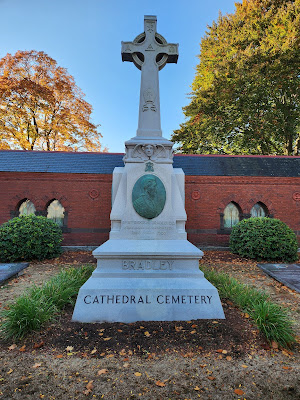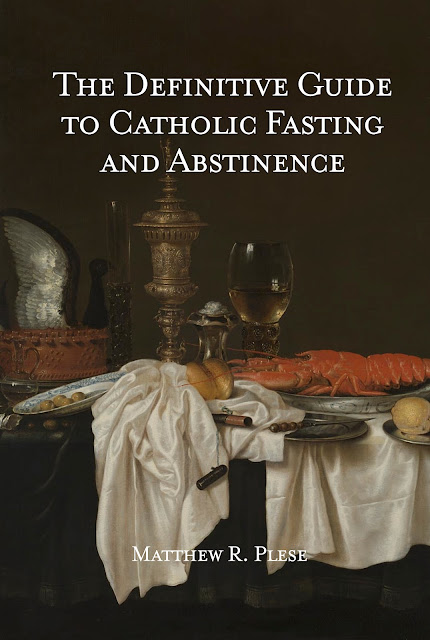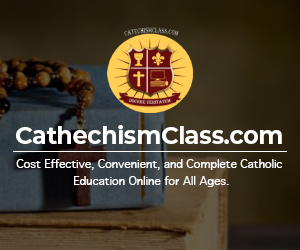The Office of the Dead is prayed by all on All Souls Day. However, you may also pray the Office of the Dead any other day of the year. The Office of the Dead on other days would be prayed in addition to the day's office. After Matins and Lauds for the day, you would pray the Office of the Dead's Matins and Lauds. After Vespers for the day, you would pray Vespers from the Office of the Dead. So, please feel free to pray this Office often for the Poor Souls, especially in November, with the intention of applying any merits and indulgences to them.
You may pray the Office of the Dead online at Divinum Officium for free now by clicking here and selecting "Defunctorum" in the bottom right.
Due to the deprecation of Feedburner's email service, those of you who had signed up for new posts from A Catholic Life may have noticed that new posts have not been emailed in some time. Here is a new service that will email out new posts when they are published. Please subscribe via email. There is no cost to do so.
If someone is planning to receive our Lord in Holy Communion at Mass, there are several requirements to keep in mind:
1. You must be a baptized Catholic who has already made his/her First Holy Communion.
2. You must not have ANY mortal sin on your soul that has not been absolved in Sacramental Confession. To receive Holy Communion in the state of sin without SACRAMENTAL confession is a sacrilege and a most serious sin. You will get no graces from Holy Communion if you do - only the most severe punishments. This was made manifestly clear in Canon 856 of the 1917 Code of Canon Law. St. Cyril of Alexandria explains further the gravity when he says, “They who make a sacrilegious Communion receive Satan and Jesus Christ into their heart. Satan, that they may let him rule, and Jesus Christ that they may offer Him in sacrifice to Satan.”
3. Observe the Eucharistic Fast before Holy Communion
4. Pay attention at Mass and be especially devout from the time of the Offertory through the Consecration and until the Priest's Communion at the end of the Canon.
5. Approach Holy Communion reverently, dressed modestly and desiring to receive our Lord who you profess is present in the Eucharistic Host in His Body, Blood, Soul, AND Divinity under the appearance (but not substance) of bread. You must receive Holy Communion reverently as well.
6. And you must approach the Sacred Altar with a proper intention. We must have a “right and pious intention.” St. Pius X lists several intentions which are not right and pious. They include approaching the altar to receive “through habit, or vanity, or human reasonings.” Thus, receiving Holy Communion just because everyone else is receiving or because we do so only to appear holy to others is not with the right intention. On the contrary, St. Pius X summarizes a right and pious intention as one that seeks “to satisfy the pleasure of God, to be joined with Him more closely in charity and to oppose one’s infirmities and defects with that divine remedy.”
Beyond these necessary conditions, St. Pius X set forth, especially for those who sought to receive Holy Communion very regularly – even daily – more perfect dispositions to strive for when he wrote: “It is especially expedient that those who practice frequent and daily communion be free from venial sins, at least from such as are fully deliberate, and any affection thereto.” As theologians have commented subsequently, there is a difference between venial sins that are fully deliberate and those venial sins that are not fully deliberate, and which we frequently call imperfections.
Traditionally, the anniversary of the consecration of a diocese’s cathedral is observed as a significant feastday in churches throughout the diocese. Written in 1908, the Catholic Encyclopedia underscores the importance of this anniversary:
“The anniversary of the consecration is kept solemnly as a double of the first class with an octave each recurring year, until the church falls into ruin or is profaned...Besides the anniversary of the consecration of individual or parish churches, the anniversary of the consecration of the cathedral of a diocese is celebrated as a double of the first class with an octave by the secular clergy living within the limits of the cathedral city...”
Sadly, Pope Pius XII in "Cum nostra hac aetate" on March 23, 1955, abolished 15 Octaves in addition to the Octave for the Dedication of a Church, and particular octaves for patrons of various religious orders, countries, and dioceses. While the 1962 Missal retains the actual anniversary day of a church or the cathedral as a First-Class Feast, few observe these venerable observances any longer. If more people were to keep the anniversary of our parish and our cathedral as days of celebration in our families, would that not bring us in greater connection to the Church as a whole? How many of us even know the anniversary date when our parish or cathedral was consecrated?
One venerable tradition connecting us to the consecration is the lighting of the consecration crosses. Each of the twelve places on the wall which were anointed as part of the consecration candle on the spot which are lit on the anniversary of the consecration.
Catholic churches are no ordinary buildings. We do not honor churches because they are museums or art galleries or works of art in themselves. Catholic churches are specifically consecrated and set aside for the worship of the True God alone.
It is so important that we honor and protect Catholic churches and help fund the construction of beautiful ones since God Himself dwells in them. He is truly present on the altar and in the tabernacle. For this reason, Catholics should piously make the sign of the Cross even when they drive past one, out of respect for the Real Presence. And we should visit them and pray before our Lord present in the Tabernacle whenever possible. Honor God by honoring that which is consecrated to Him. Honor your parishes and help us build up the kingdom of God brick by brick as we rediscover our venerable traditions.
The Rosary is regarded as the greatest prayer we can offer next to only the Holy Sacrifice of the Mass. St. Louis Marie Grignion de Montfort remarked, "The rosary is the most powerful weapon to touch the Heart of Jesus, Our Redeemer, who loves His Mother."
Indulgence for Carrying the Rosary
There are many miracles associated with the Rosary and Heaven has asked us to offer Rosaries many times. But besides these reasons, the Church blesses the Rosary with various indulgences. A plenary indulgence is granted when the rosary (i.e., 5 decades) is recited in a church or oratory or when it is recited in a family, a religious community, or a pious association. A partial indulgence is granted for its recitation in all other circumstances.
In fact, beyond praying the Rosary, an indulgence may be gained for anyone who carries a properly blessed Rosary:
The faithful who devoutly carry about their person a Rosary of the Blessed Virgin Mary that has been properly blessed may gain an Indulgence of 500 days once a day, if they kiss the Rosary and at the same time devoutly recite these words of the Angelic Salutation: Hail, Mary, full of grace; the Lord is with thee: blessed art thou among women, and blessed is the fruit of thy womb, Jesus.
Taken from Pope Pius XII, Audience March 12, 1953
But it must be added that this requires the right intention as it is not magic. To be capable of gaining indulgences, a person must be baptized, not excommunicated, and in the state of grace at least at the end of the prescribed works. To gain indulgences, however, a capable subject must have at least the general intention of acquiring them and must fulfill the enjoined works in the established time and the proper method, according to the tenor of the grant. (1983 CIC 996 §1-2)
An Example for Others
In addition to the indulgence, by carrying the Rosary on us, we will undoubtedly have times of taking it out of our pockets. This small act to show others our Catholic Faith can help bring about the respect and conversion of non-Catholics and can help subtly encourage fallen-away Catholics to return to practicing the Faith.
Start Today
If you do not carry the Rosary on you, make it a resolution to carry one in your pocket or bag at all times. And do not be afraid to take it out and pray it publicly.
As a follow-up to the significant research I have done in regard to Traditional (both Roman and Eastern) Catholic fasting and abstinence, I have put together a 2023 fasting and abstinence calendar for my own devotional purposes. This is a follow-up to a similar one I did in 2022.
To see the calendars for other years, including more recent ones, click here
Traditional Catholic Fasting Rules:
Calendar Notes:
1. Partial Abstinence is a modern invention and is not part of this calendar. Abstinence is always full, never partial.
2. All Days of Lent, aside from Sundays, are days of fasting and abstinence. Sundays are days only of abstinence.
3. For Lent only abstinence refers to all animal products (e.g. dairy, butter, eggs) in addition to meat. This includes Sundays.
5. This calendar keeps the 1954 Roman Catholic Calendar and the pre-1917 practice of anticipating Vigils on Saturday that fall on Sunday in a given year.
6. Major Fasts: Great Lent (March 2 - April 16), Apostles Fast (June 13 - June 28), Dormition Fast (Aug 1 - Aug 14), St. Martin's Lent (Nov 14 - Dec 24).
7. Dominican Specific Fasting Days: April 29, August 3, and October 6 are not on the calendar but will be observed by Dominican Tertiary per the 1923 Rule (the last one before Vatican II). Same with all Fridays of the year, which Dominicans are asked to keep as days of fasting.
8. Days of fasting generally include all of the Major Fasts as noted above in addition to the following days when they fall outside of those periods: Ember Days, Vigils of the Apostles, and Vigils for Major Feasts. Rogation Days were often days of abstinence but not fast.
9. Saturday Abstinence used to be obligatory year-round with some exceptions for days "as often as no major solemnity (e.g., Christmas) occurs on Saturday, or no infirmity serves to cancel the obligation.” One exception granted in some places was for all Saturdays of the Christmas Season to be exempted.
10. Above all, this calendar goes far beyond the mere "minimums," which are virtually non-existent, and attempts to present concrete ways for Catholics to actually fast in the manner our forefathers did.
Not listed but certainly recommendable based on the Early Church's practice of Wednesday penance (and based on the wishes of Our Lady of Mount Carmel), would be to also observe abstinence year-round on Wednesdays (beyond the dates noted on the calendar). Such a practice would be commendable on all additional Wednesdays of the year with exceptions whenever either a Holy Day of Obligation, Former Holy Day of Obligation, or First Class Feast falls on Wednesday.
For those interested in understanding the various ways fasting and abstinence have changed over time, please explore the archives regarding fasting and abstinence. And for those looking for ideas on what to make to eat on fasting days, the Lenten Cookbook produced by Sophia Institute Press has a section on vegan recipes that is worth checking out.
Want to learn more about the history of fasting and abstinence? Check out the Definitive Guide to Catholic Fasting and Abstinence.
Digital Version:
To order a digital .ics file of the above calendar that can be easily imported into your calendar application (e.g., Outlook, Google, Apple, etc.), order below.
The file is only $3.95. Please order it by clicking here.
Note that the file is a free benefit to all of my Patreon members. So if you become a patron, you will get that and many other benefits.
There Is No Salvation Outside of the Church
The Church has always taught that there is no salvation outside of the Church (Extra Ecclesiam nulla salus). This is a dogma of the Faith and must be believed. It has been affirmed by Popes and saints. For instance, Pope Eugene IV in Cantate Domino in 1441 AD declares:
"The most Holy Roman Church firmly believes, professes, and preaches that none of those existing outside the Catholic Church, not only pagans, but also Jews and heretics and schismatics, can have a share in life eternal; but that they will go into the eternal fire which was prepared for the devil and his angels unless before death they are joined with Her; and that so important is the unity of this ecclesiastical body that only those remaining within this unity can profit by the sacraments of the Church unto salvation, and they alone can receive an eternal recompense for their fasts, their almsgivings, their other works of Christian piety and the duties of a Christian soldier. No one, let his almsgiving be as great as it may, no one, even if he pours out his blood for the Name of Christ, can be saved, unless he remains within the bosom and the unity of the Catholic Church."
And St. Augustine earlier wrote: "No one can find salvation except in the Catholic Church. Outside the Church, you can find everything except salvation. You can have dignities, you can have Sacraments, you can sing "'Alleluia,' answer 'Amen,' have the Gospels, have faith in the name of the Father, the Son, and the Holy Ghost, and preach it, too. But never can you find salvation except in the Catholic Church."
Praying for the Souls of Non-Catholics Is Not Contrary to Extra Ecclesiam Nulla Salus
The Church encourages and allows private prayer for anyone, even those who died as non-Catholics since we do not know the state of their soul at the moment of death. Miraculous conversions have been won before by people who seemed to be unconscious but who, through miracles, were given the grace to choose the Faith at the moment of death. It does happen and thus we must pray for the salvation of all souls, especially for their conversion to salvation at the moment of death. And since God sees our prayers outside of time, we can pray for anyone's last-minute conversion, even long after their death. In effect, the soul will then truly die as a Catholic even if in the eyes of the world they appeared to die separated from the Faith. This is my particular prayer for Queen Elizabeth II.
The Church Permits Prayers for the Dead for Everyone
The Catholic Encyclopedia makes this clear:
"There is no restriction by Divine or ecclesiastical law as to those of the dead for whom private prayer may be offered — except that they may not be offered formally either for the blessed in heaven or for the damned. Not only for the faithful who have died in external communion with the Church, but for deceased non-Catholics, even the unbaptized, who may have died in the state of grace, one is free to offer his personal prayers and good works; nor does the Church's prohibition of her public offices for those who have died out of external communion with her affect the strictly personal element in her minister's acts. For all such she prohibits the public offering of the Sacrifice of the Mass (and of other liturgical offices); but theologians commonly teach that a priest is not forbidden to offer the Mass in private for the repose of the soul of any one who, judging by probable evidence, may be presumed to have died in faith and grace, provided, at least, he does not say the special requiem Mass with the special prayer in which the deceased is named, since this would give the offering a public and official character."
It is true that the offering of prayers and sacrifices for the souls of those in Hell is of no use. But since we do not know the state of a soul at death, we can nevertheless in an act of charity offer prayers for all of the departed. Only God judges the heart and knows the state of the soul at death (cf. 1 Samuel 16:7).
Requiem Masses Are Not Permitted for Non-Catholics
While we may and should pray for the salvation of all mankind, we do know that the public offering of the Holy Sacrifice of the Mass for the souls of non-Catholics is not permitted. Canon 1240 in the 1917 Code explicitly forbid the privilege of ecclesiastical burial rites to anyone who died as a known member of a heretical sect. Even if this distinction is not mentioned in the modernist 1983 Code, we know the 1917 Code expressed the wisdom of centuries of Catholic dogma.
This is similarly affirmed, with the distinction of public versus private prayer, in the American Ecclesiastical Review from 1896 which answers the question of whether a priest may perform funeral rites over the dead by answering:
"No, a priest cannot lawfully perform the ceremony of burial for a deceased non-Catholic or one who, having been baptized a Catholic, has defected. The presence of a priest officiating at the burial cannot be construed as a civil function, for the act of consigning a person to his grave requires no authorized witness, like the contract of marriage. The burial service of the Catholic ritual is a religious function in which we cannot share with those who deny the truth of our faith and worship, for we should implicitly, by our service, sanction the protest of the deceased against the Catholic religion. Of course, there are cases where a priest may and should bury those who are not of his faith, just as he may pray for them privately."
This is the distinction between public and private prayer. Hence, the words of Pope St. Gregory II in 731 AD are referring to public worship:
“You ask for advice on the lawfulness of making offerings for the dead. The teaching of the Church is this – that every man should make offerings for those who died as true Christians [Catholics]… But he is not allowed to do so for those who die in a state of sin even if they were Christians.”
Conclusion
May the souls of all the faithful departed rest in peace. There is no salvation outside of the Church. But God alone knows the state of a soul at death. Thus in our charity and love for all man - since we desire all to be saved - we continue to pour forth private prayers for the conversion and salvation and mitigation of Purgatory for everyone, even those who in our eyes died outside the Church but who may have made a perfect act of contrition or who became Catholic by divine intervention right before the moment of God.
God have mercy on them all, especially on the soul of Her Majesty Queen Elizabeth II and her ancestors. And may her heirs return the British Crown to public reconciliation with the Roman Catholic Church and the See of Peter.
The Martyrdom of Saint Adrian by Adrien Sacquespee (1659, Oil on Canvas)
In addition to the Nativity of the Most Blessed Virgin Mary, September 8th is the Commemoration of St. Adrian (also known as St. Hadrian). Around the year 303 AD, St. Adrian, a military officer at the imperial court, was executed at Nicomedia for his fidelity to Christ. And his feast has been celebrated since ancient times. The New Liturgical Movement, in writing about the Nativity of our Lady, shows that this day was celebrated in honor of St. Adrian for centuries:
The precise origin of the feast [of Mary's Nativity] is a matter of speculation, and the reason for the choice of date is unknown. It was celebrated at Constantinople by the 530s, when St Romanus the Melodist composed a hymn for it; by the seventh century, it had passed to the West, and Pope St Sergius I (687-701) decreed that it be should celebrated with a procession from the church of St Adrian (who shares his feast day with the Birth of the Virgin) to St Mary Major.
The following account of his life is taken from Rev. Alban Butler (1711–73)'s The Lives of the Saints, Volume IX: September. Published in 1866:
This saint was an officer in the Roman army, who, having persecuted the Christians in the reign of Maximian Galerius, was so moved by their constancy and patience, that he embraced their faith, and suffered many torments and a glorious martyrdom for the same at Nicomedia, about the year 306, in the tenth or last general persecution. His relics were conveyed to Constantinople, thence to Rome, afterwards into Flanders, where they were deposited in the Benedictin abbey of Decline, dedicated in honour of St. Peter, in the time of the first abbot, Severald. Baldwin VI., earl of Flanders, surnamed of Mons, because he married the heiress of that county, bought of a rich lord, named Gerard, the village of Hundelghem, in which stood a famous chapel of our Lady. The count founded there, in 1088, the town now called Geersbergen or Gerard’s Mount, on which, by a famous charter, he bestowed great privileges. Besides many pious donations made to that place, he removed this abbey of St. Peter, which has since taken the name of St. Adrian, whose relics, which it possesses, have been rendered famous by many miracles. Geersberg, called in French Grammont, stands upon the Dender, in Flanders, near the borders of Brabant and Hainault. St. Adrian is commemorated in the Martyrologies which bear the name of St. Jerom, and in the Roman, on the 4th of March, and chiefly on the 8th of September, which was the day of the translation of his relics to Rome, where a very ancient church bears his name.
Collect:
O Almighty God, grant that we who celebrate the birthday of Your blessed martyr Adrian may be made stronger in our love of You through his intercession. Through our Lord . . .
Disclosure of Material Connection: Some of the links on this blog are “affiliate links.” This means if you click on the link and purchase the item, I will receive an affiliate commission. As an Amazon Associate, for instance, I earn a small commission from qualifying purchases made by those who click on the Amazon affiliate links included on this website. I am disclosing this in accordance with the Federal Trade Commission’s 16 CFR, Part 255: “Guides Concerning the Use of Endorsements and Testimonials in Advertising.”
Support A Catholic Life. Your Patronage Helps Keep Us Updated and Online!
Become a Patron! Support Me On Patreon And Get Access to Exclusive Content, Free Catholic Books, Access to Discounts, and Much More!















.jpg)










